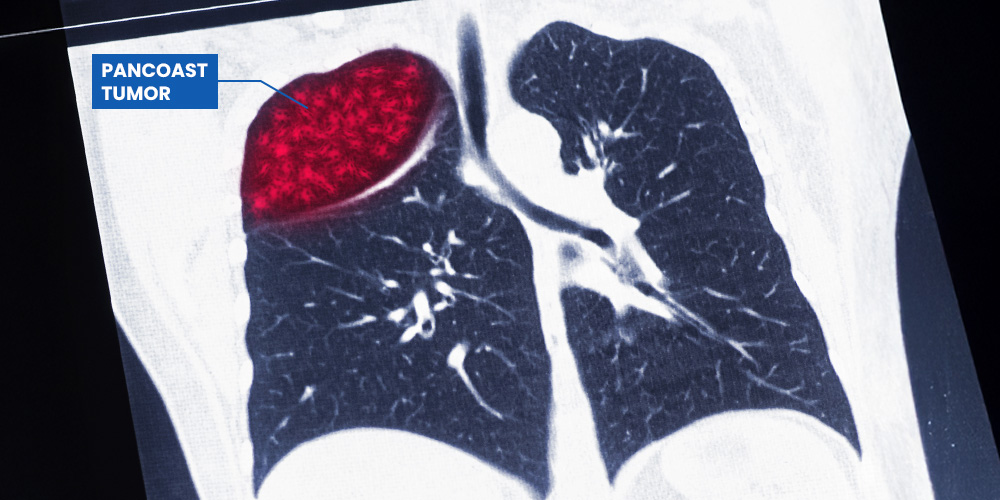
A rare and complex type of lung cancer that grows in the upper portion of the lungs, near the chest wall is known as Pancoast tumor. However, this unique tumor is distinct from other forms of lung cancer due to its location and the way it spreads, often invading nearby tissues, nerves, and blood vessels. Patients with cancer in the upper lungs may experience a range of symptoms, making early detection crucial.
Therefore, this blog will discuss what a Pancoast tumor is, its symptoms, causes, diagnosis, and treatment options, providing an in-depth understanding of this challenging condition.
What is a Pancoast Tumor?
A Pancoast tumor is a type of malignant neoplasm that arises in the apical region of the lung. It typically forms in the upper lobe and invades surrounding tissues, such as the ribs, nerves, and nearby structures. Unlike other types of lung cancer, upper lung tumors are less likely to cause symptoms like persistent cough or chest pain initially. Instead, they often manifest shoulder pain, arm weakness, and other unique signs, which can delay their diagnosis.
Tumors on the lung’s upper lobe most commonly fall under the category of Non-Small Cell Lung Cancer Clinical Trials, such as squamous cell carcinoma or adenocarcinoma. Less frequently, they can also Large Cell Lung Carcinoma be classified as or other rare forms.

Pancoast Tumor Symptoms
The symptoms of a Pancoast tumor are distinctive, primarily because of the tumor’s location near the chest apex. These symptoms are often referred to as Pancoast syndrome and may include:
1. Severe Shoulder Pain
The most common symptom is persistent pain in the shoulder or upper back, which may radiate to the arm.
2. Arm Weakness or Numbness
The tumor’s pressure on nearby nerves can cause weakness, tingling, or numbness in the arm and hand.
3. Horner’s Syndrome
In some cases, the tumor can affect the sympathetic nervous system, leading to a drooping eyelid, reduced pupil size, and lack of sweating on one side of the face.
4. Respiratory Symptoms
While less common, advanced tumors may lead to shortness of breath or other lung-related issues.
5. Weight Loss and Fatigue
As with other cancers, general symptoms like unexplained weight loss, fatigue, and lack of appetite may also occur.
Causes of Upper Lung Tumors
The exact cause of upper lung tumors is not fully understood, but several risk factors have been identified. Smoking remains the most significant contributor to the development of lung cancer, including this type. Prolonged exposure to environmental toxins, such as asbestos or industrial chemicals, is also a known risk factor.
Genetic predisposition can increase the likelihood of developing a Pancoast tumor, as can underlying conditions like chronic obstructive pulmonary disease (COPD). Although rare, these tumors may also result from metastasis, where cancer spreads from another part of the body to the lungs.
Pancoast Tumor Diagnosis
The diagnosis of an upper lung tumor can be challenging because its symptoms often mimic those of other conditions, such as arthritis or nerve compression. A thorough medical evaluation is essential to confirm the presence of this malignant neoplasm.
1. Imaging Tests
Diagnostic imaging, such as X-rays, CT scans, or MRIs, is the first step in identifying a tumor in the upper lobe of lungs. These tests help visualize the tumor and its effect on surrounding structures.
2. Biopsy
A biopsy involves taking a small tissue sample from the tumor for microscopic examination. Additionally, this step confirms the diagnosis and identifies the specific type of lung cancer involved.
3. PET Scans
Positron Emission Tomography (PET) scans can determine whether the cancer has spread to other parts of the body, aiding in staging and treatment planning.
4. Neurological Tests
Since Pancoast tumors can affect nerves, doctors may perform neurological tests to assess the tumor’s impact on the nervous system.
If you are experiencing symptoms that may point to this rare condition, consider exploring Clinical Trials for Cancer, which may offer innovative diagnostic and treatment options.
Treatment Options for Pancoast Tumors
Treatment for upper lung tumor depends on factors such as the tumor’s size, location, and whether it has spread. Due to its unique position in the body, treating a tumor in the upper lobe of lungs often requires a multidisciplinary approach involving oncologists, surgeons, and radiation specialists.
1. Surgery
Surgical removal of the tumor is a common treatment option, particularly for early-stage tumors. Procedures like lobectomy, where the affected portion of the lung is removed, are standard. However, surgery may not be feasible if the tumor has invaded critical structures.
2. Radiation Therapy
Radiation therapy is often used in combination with surgery or as a standalone treatment for inoperable tumors. Furthermore, it helps shrink the tumor and alleviate symptoms such as pain.
3. Chemotherapy
Chemotherapy is typically reserved for advanced cases or tumors that cannot be surgically removed. It may also be used in combination with radiation therapy.
4. Targeted Therapy
In some cases, targeted therapies that focus on specific genetic mutations in the tumor cells can be effective.
However, patients with advanced or recurring tumors may benefit from Neuroendocrine Cancer clinical trials, which explore cutting-edge treatments for complex cases.
Also Read: Phyllodes Tumor of the Breast: Symptoms & Treatment Guide
Living with a Pancoast Tumor
Receiving a diagnosis of upper lung tumors can be overwhelming, but with the right support and treatment plan, many patients can manage the condition effectively. Nonetheless, early detection plays a critical role in improving outcomes. This is why it is essential to recognize Pancoast tumor symptoms and seek medical attention promptly.
Support groups and counseling services are valuable resources for patients and families coping with the emotional impact of a malignant neoplasm diagnosis. Additionally, regular follow-ups with your healthcare provider ensure that any changes in your condition are addressed promptly.
Prevention and Risk Reduction
Although not all cases of upper lung tumors can be prevented, taking proactive steps to reduce risk factors can significantly lower your chances of developing this rare form of lung cancer.
1. Quit Smoking
Smoking is the leading cause of lung cancer, including Pancoast tumors. Nonetheless, quitting smoking reduces your risk and improves overall lung health.
2. Avoid Environmental Toxins
Limit exposure to harmful substances like asbestos, industrial chemicals, and air pollution whenever possible.
3. Maintain a Healthy Lifestyle
Regular exercise, a balanced diet, and adequate hydration contribute to overall health and can reduce cancer risk.
4. Regular Medical Check-ups
Early detection is key. Schedule routine check-ups, especially if you have a family history of cancer or other risk factors.
Conclusion
Understanding what is a Pancoast tumor and its unique symptoms is critical for early detection and effective treatment. Unlike other types of lung cancer, this condition primarily affects the upper lung and surrounding tissues, making diagnosis more complex.
However, with advancements in imaging techniques and treatment options, including surgery, radiation, and chemotherapy, the outlook for patients continues to improve. Moreover, for those seeking innovative solutions, participating in Clinical Trials for Cancer can offer access to cutting-edge therapies and personalized care.
If you suspect you may have symptoms related to this rare condition or need support managing a malignant neoplasm, consulting a healthcare professional is the first step. Therefore, stay informed and proactive in managing your lung health to lead a fulfilling life.







